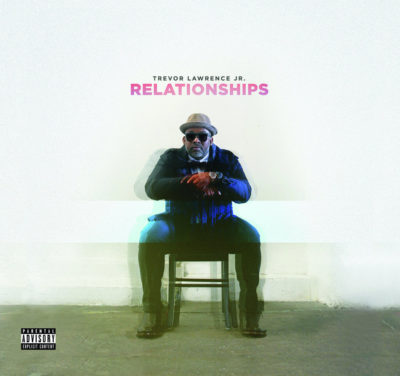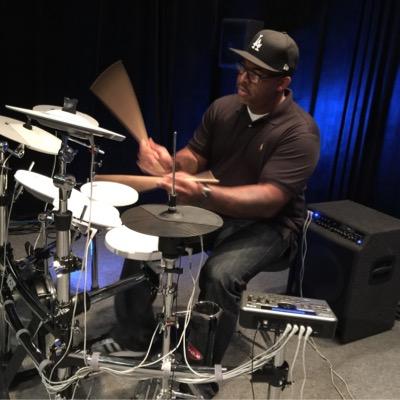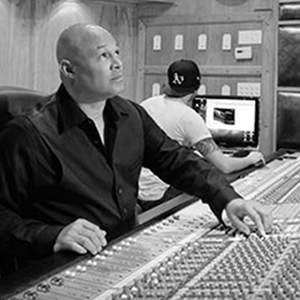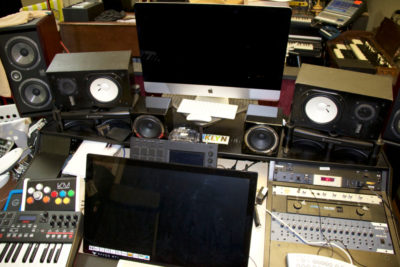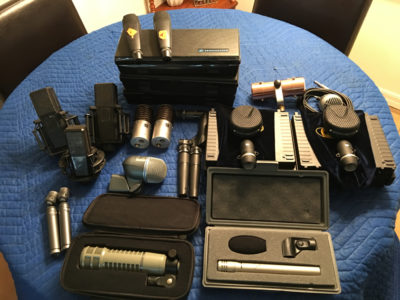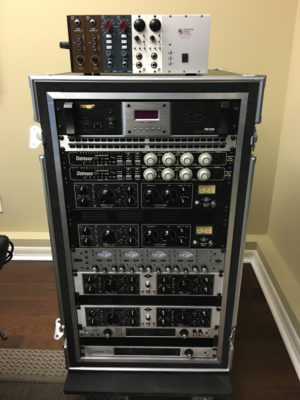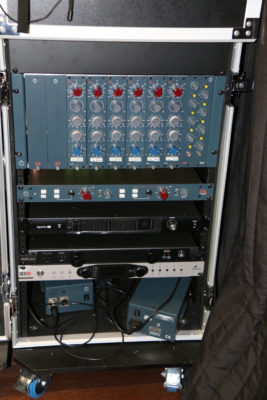Drummer’s Revenge: Producer Trevor Lawrence Jr. Leverages His ‘Relationships’
“Boom!”
When Trevor Lawrence Jr. talks, that’s your signal he’s on to something. Whether this LA-based product of music royalty is discussing drum tracking, mixing, or producing at his Woodland Hills studio 3 Pillars, a “Boom!” is bound to come out of his mouth. Pay extra attention when that happens, because that’s not just a gestalt – it’s the product of a literal lifetime with music.
To get the “Boom!” all at once, with no waiting, then obtain his new album Relationships, available now on Ropeadope Records. A remarkably diverse record, its packed with the energy, classic influences, and fresh discoveries you’d expect from a guest star list that includes Terrace Martin (The Polyseeds), Kenneth Crouch, Nicholas Payton, Maurice Brown, LeAnn Rimes, Kamasi Washington, and Nico Segal (Donnie Trumpet). Did we mention positive vibes? The lead single “Lovestoned” proves that.
Add in the fact that Lawrence Jr.’s mother performed with the Supremes, and along with his saxophonist father they were original members of Steve Wonder’s Wonderlove band. Next consider that Lawrence Jr. started recording serious drum sessions as a high schooler, then went on to record and/or produce with Rimes, Bruno Mars, Ed Sheeran, Snoop Dogg, Quincy, Alicia Keys, Kendrick Lamar, Stevie Wonder, Eminem, and Dr. Dre.
It stands to reason that Lawrence Jr. has picked up a studio trick or three. In this interview, he shares insights on career expansion, producer best practices, recording drums, and his surefire methods for a maximum mix. Clear your head now — make room for the BOOM.

Trevor, “Relationships” has so many feels from track to track, but it all fits together as a cohesive whole. How do you as a producer and artist present an album that’s diversified?
I haven’t yet met a musician at a high level that’s not also a historian of some sorts. Everybody I know that plays incredibly and does what they do knows something about their genre, of course, and then others as well. The real cats that really do this stuff can talk to you about so many different types of music. I’ve always been a student of that my whole life.
So I listen to all different things. I try to get into the mechanics of what makes what kind of sound, especially drum-wise. And I spend a great deal of my life doing that, still to this day. I still have the same energy I did when I was a little kid just learning about stuff. Even though I’ve learned a lot, I still am trying to learn what’s the new thing. What’s that? What’s the new trend? How are people recording this?
I do a lot of (drum recording) sessions when people send them to me over, especially over the last five years, so I have to be able to capture these different sounds and also compete with different studios and rooms. If you go listen to Leanne Rimes’ Remnants album that’s out now, half of it’s done at Capitol and the Village, and other half’s done in my studio. You know what I mean? You can’t tell what’s done where.
So the first thing is trying to just know about the genres you’re recording, so you play the right idiom. That’s my thing, is being actually honest and authentic with each one of these genres. And then the sound thing is the second most important thing, because you need to have the right sound for the right genre. I don’t like imposing the wrong sound for the wrong genre. I have an issue with playing really straight-ahead bebop on big drums, for example. That’s not the sound.
You can have all the theory and feel that you want, but as another example upright and electric bass in the jazz world — straight ahead traditional jazz — are two different animals. We’re dealing with physics, so if you change the bass it makes the music sound differently. I’m not saying there’s any rules against that, I’m just saying that I like to be as authentic as I can.
It also depends on the producer. If I’m just a player, I’m working for them. So they’re telling me, “Hey man, we love this song, we love that song. I want it to be a mix of this and that.” There’s always these grandiose concepts that you have to make into some sort of reality, right? So then it’s, “OK, I understand what you’re saying,” and then, boom! Here’s the drums I’m going to play for that.
That’s the way I am. That song’s sound is going to be these high hats and these microphones, and on this song I’m going to use more of the room or throw one of my (Coles) 4038’s on a Distressor. So it’s almost like you’re a musician and an engineer and a producer, even if you’re just a player. You’re all of those things. (laughs) It pays to learn — I’m a big nerd but it all paid off. It’s like, I don’t care that I spent so much time on Pro Tools as opposed to being out in the street. Now it paid off.
How would you describe the mindset you take on when you’re listening to music from that engineering standpoint?
It’s this constant scientist thing. My dad has a term called “constant analysis.” I just never stop, because now as a producer those are things you have to know. So I’ve always got my producer cap.
My best friend is Mike Elizondo. We did our first bands together, we still work together quite a bit. You know his work, from all the Dre hits to Maroon 5 to getting nominated for “Producer of the Year” to 21 Pilots. He’s ridiculous and he’s been vice president of Warner Brothers for like seven years. He’s one of the ones.
Mike is a bass player first, he’s one of the greatest bass players. He went into producer mode and I saw him when he was studying he really got into the Beatles, and all the things that made up all these records. But once again a historian! You could sit down and talk to him about all these stories behind the record and what amp it was and he was going to know it. Everybody I know on that level can have those conversations.
At the end of the day I’m always decoding or trying to decode what it is so that if I get called I’m prepared. One of my favorite calls parts of a call is when they say, “We want you to play drums.” “So what’s the vibe?” That’s my favorite question, because then they say, “Oh, we’re going for this.” And then, boom! I tell my people what (drums) to bring of mine because I try to have everything. I don’t really rent drums. I have, like, a whole community at Drum Doctor’s in my area. That’s how big it is! (laughs) There’s just a ridiculous area, bro. And then I also have a crazy amount of gear in Nashville. That’s just because I always want to be ready. I want to be able to play whatever. Whatever they call for, I want to be able to have that sound or know how to get it.
Drummer AND Producer
When would you say you started transitioning seriously to becoming more than a drummer, and a producer as well?
The first part of my life I was developing being a drummer and I was a jazz musician. And then I remember when I got into the MIDI stuff when I was about 13, and I got heavily in hip hop. And there was a period where in college I was still playing but I started a production thing trying to take it seriously to where there was a period where I was renouncing drums: “No, I’m a producer now! I’m not a drummer.” And then of course everything circles back, and then once you get one side of your career up and then the other side of the career up then nobody cares that you do both.
But it’s hard when you’re a drummer because — I don’t know why society is like this — but people can understand a D.J. being a producer before a drummer, which I don’t understand. With drummers, nobody really wants to give you a shot or believe because they don’t think that you know enough, so you have to be above and beyond. Unless you’re like Dave Grohl where you’re in the rock situation, in the band, nobody questions that — that’s a natural progression. People can see that. But I mean Narada Michael Walden, I love his example because he came from a fusion sound like Billy Cobham, and then produced Whitney Houston.
I think that’s a great transition to see because that was a cat that really could play and he really went extreme commercial in pop and had a lot of success. So I would say it’s about half and half (producing and drumming) in my life. I’m 43 now. I definitely had a period where I was just focused on production — my first record came out when I was really young. I produced this record for the rap version of the Boy Scouts creed for a Boy Scouts record, I was like 14 years old and I was like, “Wow! Something on vinyl!” Then I got the bug. I’ve been around it all my life. My father produced “I’m So Excited” and countless other big American classic records, so I saw production my whole life.
What are some of the best practices you’ve picked up on producing along the way, whether from your father or pioneers like Dr. Dre? What do you channel from them when you’re producing a record?
(laughs) Well, a lot of being a producer to me is about personalities and relationships. Sometimes you’re more of a shrink, and you have to wrangle personalities and get people into the mind state that they’re going to execute their best of whatever they have, they’re going to give you their best in the moment you need them to give it to you. And that’s tough — you run a lot of different things to get that moment right.
But it’s all about the moment. When people do vocals with Dr. Dre, a lot of times, man, it’s the first time they’ve ever seen themselves be able to be pushed to that potential. It’s like they didn’t realize where they could even go themselves, because they’ve been shortchanging it all these years. That’s how intense it is, he does not settle unless it’s perfect. Period.
In that process I’ve been there with them so many times now you know, it’s just an incredible thing to see. So from him I’ve picked up the work ethic. When it’s time to lock in and go you have to be 100 percent focused on it or don’t do it.
The other thing is knowing the people to call. I grew up with my dad using Nathan East and Paul Jackson Jr. I’ve seen these cats, and when I started working with them later in life they’ve been the guys for decades.
I learned a lot from Mike too because Mike’s thing was he came from the production school also of being able to get any sounds. Whatever direction or sound, by the time the project’s over he has the instruments, he has that formula. And then when we have to go back to get that sound he already knows all that stuff. If I want to get an old-school ’70’s Doors sound, an AC-DC sound, boom! This is what I’m going to do. He has the formula. So I learned that from him.
And that’s a lot of the reason why I have amassed so much gear in my own right is because I like to have these sounds available. Right now, I’m going through another transition because I’m looking forward to doing my next record, and I’m going to have a nontraditional keyboard sound, because the Rhodes and the MiniMoog, we’ve all used that for years now, it’s not even old school anymore because it’s been used so much. So I’m going to another period, my ’90’s keyboards. I’ve got a (Yamaha) CP-70 which was a whole other kind of piano sound and, you know, an organ that’s not a B3.
Equipping the Studio
How is your studio, 3 Pillars, set up for the way you work, as a producer and a recording artist?
I don’t have an analog desk, but I have a desk not in a desk, know what I mean? (Laughs) I love the concept of a desk, but in the way that we record today, recording to Pro Tools makes that a different consideration. My space is a converted garage, very well converted and a great build, but it’s still not the space of Record Plant or something. Great mixers like Manny Marroquin and everybody else get Pro Tools files. So the whole key is you get those files to sound great any way possible.
I’ve done sessions at big studios with huge engineers, and then when you take the sessions somewhere else it doesn’t sound like that, because anything great happened in the board, and it wasn’t recorded like that. Sometimes people do that to keep themselves inserted, and I understand that, but at the end of the day the way we make records now that record might go to 10 people for overdubs all over the world.
So I decided that I my whole thing was pre-Pro Tools. I don’t want to have to pull up plugins later after I’ve done what I’ve done to make it sound good. So that’s where the beauty of things like the Universal Audio Apollo comes in because I just feel like I have any piece of gear that I ever could want at my fingertips.
And then a lot of it becomes financial. You’ve got to decide if you’re going to put that amount of money into it, if it matters to you. I have a whole rack of Neve 1073’s, the real-size ones and usually most people studio’s cost that much. So these are things you have to decide.
What are some of your mic choices?
My microphone collection, everything for me was based off drums, mics that are the staple mics for drums, and then of course some extra things.
For toms, that means Sennheiser 421s. On the kick I have the Shure Beta 52 or AKG D112, Solomon sub, a homemade sub mic, an Electro-Voice RE20, and Neumann Fet U 47. For overheads or room mics, I use Manley Reference and Coles 4038’s — I love running them through Distressors which is a great sound, in addition to the full kit. I’m a big fan of the Shure SM57 on snare, and speaking of Shure a Cloudlifter on an SM7 through there is a special thing. It just takes that mic and it just becomes so rich. I’ve used them on vocals, all types of stuff, it’s crazy dude, crazy! (laughs).
Now the other flip that I just got hip to that’s changed my life is the new stereo AEA ribbon (the R88 mk2). That thing right there and then I bought the mic pre’s that go with it (the RPQ500). And then the Slate VMS (Virtual Microphone System), is a problem. That thing is unbelievable! I’m using it more for the (Sony) C-800.
On a regular four-piece kit, I track a 16-channel drum sound. I just make sure they get the room and the three-combination bass drum: the sub, FET and inside. Because a lot of it’s remote and they know they can do however they feel fit, they might not want the rooms, they might not want the stereo ribbon. I just give them all of those, so they can have a choice.
What are your outboard highlights?
One of my racks has the two AEA pres for the stereo ribbon, a lunchbox with two API 312 types, two 500-seriess 1073’s, plus two more pre’s [make unknown] which are specifically for turntables, DJs. There are also two Manley Cores, the Manley Force four-channel pre — I put the Manley references through the Cores, which sound great. Then I have two Distressors, two Universal Audio LA-610 tube channel strips, Universal Audio 4-710D four-channel tone-blending mic preamp, and two UA 2-610 Dual Channel Tube amplifiers. The other rack is eight channels of BAE 1073.
All of my interfaces are Universal Audio Apollo – an original Apollo, Apollo 16, and black Apollo 16. My converters are all via the Apollo’s, with an Antelope OXC HD Master clock. My monitors are Yamaha NS10’s, Focal Twin 6Be, and Avantone Cubes, all with a Dangerous Monitor section. All studio monitoring is Aviom and all headphones are Blue.
My controller is a dual Slate Raven MTi. I co-own a software company called MVP Loops. We’re pretty hefty in the plugin world, and so Slate is another one of our partners that we deal with. I’m an early adopter of the Raven. I have one Raven in my main control area, and then I have another one that’s on the stand that that follows me around the studio, so if I’m playing drums or percussion or somewhere else then I still control everything.
Then on the travel tip, I have a travel rig which is the Universal Audio Apollo Twin (Thunderbolt audio interface), I just got their new Quad, and then my computer with an 8-terabyte drive. I’m going to travel with this thing because a lot of times I just travel with the gear to write with, but sometimes when I was in the record process I travel actually with a microphone, to capture some acoustic guitar or stuff like that.
I’ve been there since the beginning right since the beginning when Universal Audio came out with the first Apollo. The gear was changing and I could sense the flow, like, “Wow I don’t have to have all these cards, and they have all these plugins but it doesn’t weigh down my computer?” That was the main game right there. I thought that was genius. And when the Twin came out me and all my guys that worked with me and Dre at the time all had them, because we work off laptop rigs and you’re constantly back and forth to home to the studio, and we travel to Hawaii and work. So those things sound amazing, and now with this Quad you can use so many more plugins.
But, dude this is so little but it’s so huge: They put a talkback button on (the Twin)! I mean when you’re cutting vocals, and you do the makeshift hotel-room-bathroom-comforter-up-over-the-shower-curtain-rod — that whole thing is a road technique we use — you’re still in another room. So if you don’t have talkback you’re like (shouting), “HEY! I NEED YOU TO DO IT AGAIN!” It gets annoying. It made that whole thing so much easier.
What are the plugins that you’re gravitating to?
I use the Shadow Hills mastering compressor plugin a lot on the stereo buss. I have an engineer so he has his own that really loves the (EMT 140) plate reverb, he uses that reverb a lot. We use API EQ’s lot. But as far as drums, any of those plugins are all inserted on console so it’s all printing with the sound of my real pre’s and whatever EQing I do there, that’s printing. If you pull it up with no plugins or if you just have the waveforms on a different DAW — because some people don’t use Pro Tools, rare as it — I want those waves to sound right, right off the top. A guy flew out here from the Bay Area, he worked with me on Monday and he uses Logic. So my mindset is that this has to sound good, but you can’t rely on plugins to sound good.
How would you characterize your philosophy when you’re mixing?
You know the important thing I learned about mixing? Here’s the quote: The most important thing about mixing is…record it right! (laughs).
I mean, no matter what I still am a musician and not a magician. I’m not a commercial guy taking projects from everywhere, so I’m only working on stuff that I’m affiliated with. The important thing that I’ve learned is record it right. Because I definitely was brought up with that that whole catch phrase that so many of us know, which was “just fix it in the mix.” But record it right and then the mix is going to come out a lot better.
Making the Most of ‘Relationships’
Let’s talk about your new album, Relationships. “Lovestoned” is an addictive lead single, just for starters.
I appreciate that. There’s a song on the record called “Relationships,” and when that song was written I was like, “Wait a second, boom!” This is the kind of relationship I was looking for, with so many guest artists on the album.
I told the trumpet player Nicholas Payton, “We’ve gotta call this album ‘Relationships,’ a one-word title. Nicholas, for example, that guy is just unbelievable man. I mean this dude was on tour, he’s cutting it up for me on tour, taking the time out, a real stand up great guy. And Leann (Rimes), we work together, I play with her live, on her newest record. We talked about it, we tried to work it out, and we said we were going to do it. Sometimes those things don’t work out — she made it happen! That to me speaks to the relationship.
On my album, everything is live and real, all the strings and all the horns. You’re not going to hear any keyboard strings or anything like that. Obviously that costs a lot a lot a lot of money! (laughs) But again to the relationships, I was able to make it all work, because of how I’ve worked with people in the years.
And then Terrace Martin, we’re very close friends, we worked for 20 some years, we worked together in Herbie (Hancock’s) band. But at the end of the day, still we all have schedules and we all have stuff, and he’s a real well-known artist in his own right, and we were able to make it work. He actually introduced me to the people at Ropeadope, to the label guy.
I like people to listen to it in the order, so you can see the whole picture of how the album goes. I’m really happy how it came out. The Leann song (“Lovestoned”) was just one of these things where it was basically me saying, “I’m tired of these boxes.” So what happens when you put a former country artist, and then a great very well-known jazz artist (Nicholas Payton) and then my EDM Group Drumpimp.
So what do you call that that, when you put a song with all those guys together? You can see the panorama drone shots of huge — the Sahara — when you listen to that record. At the end of the day, relationships are literally like real art. It’s the art of my life! It’s what everything has been patterned after.
- David Weiss
Please note: When you buy products through links on this page, we may earn an affiliate commission.







